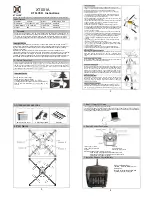
62
f) Flip Function
The model can perform a flip (a 360° turn). For this, put the quadrocopter into a stable hover flight (at an altitude of at
least 1.5 metres) at sufficient distance from the pilot and any obstacles.
Now push the transmitter's button "360° flip" (figure 5, item 11). The transmitter will emit a control sound at an even
rhythm to confirm that you have chosen flip mode. The control sound will remain activated until the flip is completed.
Now, briefly put the right control lever in the direction in which the flip is to take place.
Examples: If you push the right lever forward, the quadrocopter will turn over forwards. If you push the right control
lever to the right, the quadrocopter will turn over to the right.
After you have specified the flip direction at the transmitter, put the right control lever into the neutral position again
at once.
Attention!
The flip function generally must only be used if the model is flown in a large hall/in a large room or outdoors,
is in a stable flight condition (hovering) before the respective operating button is pushed at the transmitter,
the flight height is not below 1.5 metres and the quadrocopter is at least 5 metres away from obstacles and
persons. If this is not observed, there is a danger of damage to the model or other objects nearby and a
danger of injury to persons/animals in the vicinity from contact or crash!
When the model is already in "Low Batt mode" (LEDs at the quadrocopter flash), the flip function is deacti
-
vated for reasons of safety and therefore cannot be performed.
The model can perform a flip function only in one direction (only forward or backward; only to the left or
right) and therefore also requires the corresponding clear control commands from the transmitter (right
control lever forward or back; right control lever to the left or right). Therefore, avoid inadmissible control
commands when the flip function is activated, such as "right control lever pushed to the front+left". In such
cases, there may be uncontrolled flight conditions and crashes.
After a flip, the function is automatically deactivated at the transmitter. If you want to perform another flip,
you need to activate the flip function at the transmitter first.
g) Headless Mode
Headless mode is a relative control mode, i.e.no matter the alignment of the quadrocopter, it will always fly to the right
when viewed from the pilot's position when steering to the right - no matter if the model points backwards, to the left,
front or right. The quadrocopter is shown the direction into which it is to go with the right control lever (nod and roll)
at all times.
Important!
The transmitter and the quadrocopter must be aligned precisely in the same manner when the headless
mode is activated! Therefore, this function cannot be used when the quadrocopter is on the ground instead
of in the air. The front (blue) LEDs are pointing forward. If this is not observed, the results will be unex-
pected, i.e. the quadrocopter will not fly where it is told to go.
The headless mode is implemented in the model with relatively simple means (e.g. without compass /
GPS-support). Therefore, deviations and inaccuracies in flight course determination or return accuracy are
normal.





































